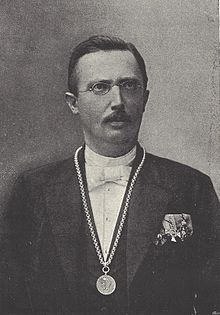Karl Wilckens
Karl Wilckens (born November 23, 1851 in Tauberbischofsheim , † January 6, 1914 in Heidelberg ) was a German local politician . From 1885 to 1913 he was Lord Mayor of Heidelberg.
Career
Wilckens studied law . He worked in various functions within the local government in Mannheim , Heidelberg and Bonndorf in the Black Forest until he was elected mayor on January 15, 1885 by the Heidelberg Citizens' Committee . A re-election by the citizens' committee took place on March 16, 1903. On December 4, 1913, Wilckens resigned from his position as Lord Mayor of Heidelberg due to a serious illness.
From 1887 to 1909, Karl Wilckens was a member of the Second Chamber of the Baden Estates Assembly . There he belonged to the faction of the National Liberal Party . In 1906 Wilckens became President of the Second Chamber and from 1907 to 1908 its Vice-President. From 1909 until his death, Wilckens was a member of the First Chamber of the Baden Estates Assembly .
Honors
- On December 3, 1913, Karl Wilckens received honorary citizenship of the city of Heidelberg.
- The following are named after K. Wilckens:
Karl Wilckens found his final resting place in the Heidelberg Bergfriedhof in the (Dept. Y). The tomb is dominated by an oversized granite menhir .
literature
- Leena Ruuskaanen: The Heidelberg Bergfriedhof. Selected gravesites , Heidelberg 1992
- Andreas Cser: Brief history of the city and University of Heidelberg , Karlsruhe 2007, ISBN 978-3-7650-8337-2
See also
Web links
- Information on the website of the Heidelberg History Association
- Wilckensfels natural monument in the Russenstein nature reserve
- Speeches by Karl Wilckens in the Baden state parliament in the digital collections of the Badische Landesbibliothek
| personal data | |
|---|---|
| SURNAME | Wilckens, Karl |
| ALTERNATIVE NAMES | Wilckens, Carl |
| BRIEF DESCRIPTION | German politician, Mayor of Heidelberg (1885–1913) |
| DATE OF BIRTH | November 23, 1851 |
| PLACE OF BIRTH | Tauberbischofsheim |
| DATE OF DEATH | January 6, 1914 |
| Place of death | Heidelberg |
